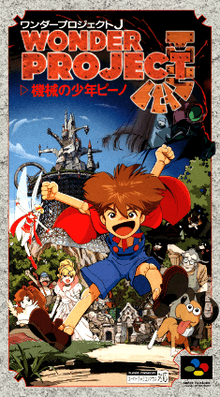Wonder Project J
Wonder Project J[lower-alpha 1] is a Japan-exclusive video game published by Enix for the Super Famicom in 1994.
| Wonder Project J: Kikai no Shōnen Pīno | |
|---|---|
 Cover art by Toshihiro Kawamoto | |
| Developer(s) | Almanic |
| Publisher(s) | Enix |
| Director(s) | Takashi Yoneda |
| Designer(s) | Takashi Yoneda |
| Artist(s) | Toshihiro Kawamoto (character design) |
| Composer(s) | Akihiko Mori |
| Series | Wonder Project |
| Platform(s) | Super Famicom |
| Release |
|
| Genre(s) | Life simulation game |
| Mode(s) | Single-player |
Gameplay
The game is a raising simulation in which the player raises a Pinocchio-esque boy.[1][2][3][4] The game uses a point and click interface like an adventure game. The goal of the game is to educate the boy robot to attempt to make him more human. This can be accomplished by scolding him when he does something wrong, and praising him when he does something right.[3] The game features a very large amount of animations for the robot boy, which attempt to make the boy appear more human to the player.[3] The robot's whose default name is "Pino", and he needs to succeed in various challenges and confrontations to activate virtue circuits, with his final task to foster relations between humans and the robot-like Gijin.
Development
The game was developed by Almanic, which also developed the Enix-published E.V.O.: Search for Eden.[5] Toshihiro Kawamoto worked as artist for the game and also illustrated the cover art.[6][7]
Release
The game was released in Japan on December 9, 1994 for the Super Famicom.[8]
The game, and its sequel were ported to the iPhone in 2010.[9]
Reception
| Reception | ||||||||||
|---|---|---|---|---|---|---|---|---|---|---|
| ||||||||||
In April 1995, Famitsu's "Reader Cross Review" section gave Wonder Project J a 7 out of 10.[13] The game was a commercial hit, with sales of 1.3 million units in Japan alone.[14] Hardcore Gamer gave the title a positive retrospective outlook.[15] In 2011, 1UP.com's Bob Mackey listed it among the "Six Must-Play Super Nintendo Imports".[6]
Sequel
Its sequel, Wonder Project J2, was released on the Nintendo 64 two years later.[5]
Notes
References
- de Costanzo, Nic; Nicholson, Zy (February 1995). "Super Express: Fantasy Quest - Project J". Super Play. No. 28. Future Publishing. pp. 14–15.
- "Big in Japan: Wonder Project J - Un Pinocho a la japonesa". Hobby Consolas (in Spanish). No. 42. Hobby Press. March 1995. p. 14.
- "Nintendo News: Occhio, Malocchio, Prezzemolo e Pinocchio". Mega Console (in Italian). No. 29. Futura Publishing. September 1996. p. 24.
- Sczepaniak, John (4 May 2017). "Wonder Project J". Hardcore Gaming 101. Retrieved 16 August 2020.
- Ciolek, Todd (6 August 2012). "Falls from Grace: How Four Creative Game Companies Went Astray - Givro: Growing Pains". 1UP.com. IGN. Archived from the original on 2 November 2012. Retrieved 16 August 2020.
- Mackey, Bob (19 August 2011). "Six Must-Play Super Nintendo Imports - Check out the best 16-bit games you (probably) never played (Page 2)". 1UP.com. IGN. Archived from the original on 7 June 2016. Retrieved 16 August 2020.
- Brett, Stuart; Jarratt, Steve (5 January 2016). Wonder Project J. Super Famicom: The Box Art Collection. Bitmap Books. pp. 1–276. ISBN 978-0993012969.
- "ワンダープロジェクトJ~機械の少年ピーノ~" (in Japanese). Square Enix. 2020. Archived from the original on 24 July 2017. Retrieved 16 August 2020.
- Sahdev, Ishaan (19 April 2010). "Wonder Project J2 Heading To iPhone". Siliconera. Curse LLC. Archived from the original on 25 September 2016. Retrieved 16 August 2020.
- "NEW GAMES CROSS REVIEW: ワンダープロジェクトJ -機械の少年ピーノ- (SFC)". Famitsu (in Japanese). ASCII Corporation. 1994. Archived from the original on 15 August 2018. Retrieved 16 August 2020.
- 超絶 大技林 '98年春版: スーパーファミコン - ワンダープロジェクトJ 機械の少年ピーノ. PlayStation Magazine (Special) (in Japanese). 42. Tokuma Shoten Intermedia. 15 April 1998. pp. 1–430. ASIN B00J16900U.
- Bros, Marjorie (September 1995). "SNES - Wonder Project J". Super Game Power (in Portuguese). No. 18. Nova Cultural. pp. 24–25.
- "読者クロスレビュー: ワンダープロジェクトJ -機械の少年ピーノ-". Famitsu (in Japanese). No. 330. ASCII Corporation. 14 April 1995. p. 31.
- "Features: Played in Japan - The next wave of Far Eastern RPGs (Page 5)". Next Generation. Imagine Media. 1996. Archived from the original on 6 June 1997. Retrieved 16 August 2020.
- "Forgotten - Games America Forgot". Hardcore Gamer. Vol. 5 no. 1. Prima Games. June 2009. p. 61.